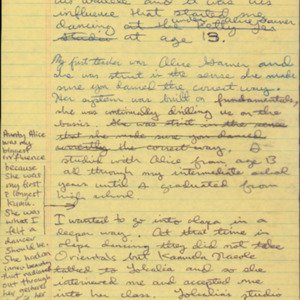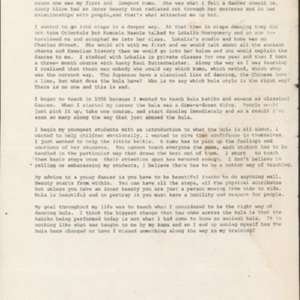Rose Look
Title
Rose Look
Description
Rose Look
Rose Look has taught the hula for twenty-seven years and resides today in Ewa Beach, O‘ahu. In 1945 she produced an album and a single entitled “Darling Kuʻuipo” which became a theme song for her in the late 1940s.
When I was growing up my father was very close to a Hawaiian family who lived on Pensacola Street called the Lamberts. My father loved to play his ‘ukulele and sing Hawaiian songs. His influence prompted me to learn the hula under Alice K. Garner at the age of thirteen.
She was my first teacher and she was strict in the sense she made sure you danced the correct way. Her system was built on fundamentals and she was continually drilling us on the basics. I studied with Alice from age thirteen all through my intermediate school years until I graduated from high school. She was my biggest influence because she was my first and longest kumu. She was what I felt a dancer should be. Aunty Alice had an inner beauty that radiated out through her gestures and in her relationships with people and that’s what attracted me to her.
I wanted to go into ‘ōlapa in a deeper way. At that time in ‘ōlapa dancing they did not take Orientals but Kamuela Nae‘ole talked to Lokalia Montgomery and so she interviewed me and accepted me into her class. Lokalia’s studio and home was on Charles Street. She would sit with me first and we would talk about all the ancient chants and Hawaiian history, then we would go into her hālau and she would explain the dances to me. I studied with Lokalia in private classes for one year and then I took a three-month course with Aunty Kau‘i Zuttermeister. Along the way as I was learning I realized that there was nobody who could say which kumu, which method, which step was the correct way. The Japanese have a classical line of dancing, the Chinese have a line, but what does the hula have? Who is to say which hula style is the right way? There is no one and this is sad.
I began to teach in 1956 because I wanted to teach hula kahiko and ‘auwana as classical dances. When I started my career the hula was a dime-a-dozen thing. People would just pick it up, take one course, and start dancing immediately and as a result I’ve seen so many along the way that just abused the hula.
I begin my youngest students with an introduction to what the hula is all about. I wanted to help children emotionally; I wanted to give them confidence in themselves. I just wanted to help the little keikis. A kumu has to pick up the feelings and emotions of her students. You cannot teach everyone the same, each student has to be handled in the particular way that draws the best out of them. I start to teach them basic steps once their attention span has matured enough. I don’t believe in yelling or embarrassing my students, I believe there has to be a better way of teaching.
My advice to a young dancer is you have to be beautiful inside to do anything well. Beauty starts from within. You can have all the steps, all the physical attributes but unless you have an inner beauty you are just a person moving from side to side. Hula is beautiful and to portray it you must have a humility and respect for people.
My goal throughout my life was to teach what I considered to be the right way of dancing hula. I think the biggest change that has come across the hula is that the kahiko being performed today is not what I had come to know as ancient hula. It is nothing like what was taught to me by my kumu and so I end up asking myself has the hula been changed or have I missed something along the way in my training?
Rose Look has taught the hula for twenty-seven years and resides today in Ewa Beach, O‘ahu. In 1945 she produced an album and a single entitled “Darling Kuʻuipo” which became a theme song for her in the late 1940s.
When I was growing up my father was very close to a Hawaiian family who lived on Pensacola Street called the Lamberts. My father loved to play his ‘ukulele and sing Hawaiian songs. His influence prompted me to learn the hula under Alice K. Garner at the age of thirteen.
She was my first teacher and she was strict in the sense she made sure you danced the correct way. Her system was built on fundamentals and she was continually drilling us on the basics. I studied with Alice from age thirteen all through my intermediate school years until I graduated from high school. She was my biggest influence because she was my first and longest kumu. She was what I felt a dancer should be. Aunty Alice had an inner beauty that radiated out through her gestures and in her relationships with people and that’s what attracted me to her.
I wanted to go into ‘ōlapa in a deeper way. At that time in ‘ōlapa dancing they did not take Orientals but Kamuela Nae‘ole talked to Lokalia Montgomery and so she interviewed me and accepted me into her class. Lokalia’s studio and home was on Charles Street. She would sit with me first and we would talk about all the ancient chants and Hawaiian history, then we would go into her hālau and she would explain the dances to me. I studied with Lokalia in private classes for one year and then I took a three-month course with Aunty Kau‘i Zuttermeister. Along the way as I was learning I realized that there was nobody who could say which kumu, which method, which step was the correct way. The Japanese have a classical line of dancing, the Chinese have a line, but what does the hula have? Who is to say which hula style is the right way? There is no one and this is sad.
I began to teach in 1956 because I wanted to teach hula kahiko and ‘auwana as classical dances. When I started my career the hula was a dime-a-dozen thing. People would just pick it up, take one course, and start dancing immediately and as a result I’ve seen so many along the way that just abused the hula.
I begin my youngest students with an introduction to what the hula is all about. I wanted to help children emotionally; I wanted to give them confidence in themselves. I just wanted to help the little keikis. A kumu has to pick up the feelings and emotions of her students. You cannot teach everyone the same, each student has to be handled in the particular way that draws the best out of them. I start to teach them basic steps once their attention span has matured enough. I don’t believe in yelling or embarrassing my students, I believe there has to be a better way of teaching.
My advice to a young dancer is you have to be beautiful inside to do anything well. Beauty starts from within. You can have all the steps, all the physical attributes but unless you have an inner beauty you are just a person moving from side to side. Hula is beautiful and to portray it you must have a humility and respect for people.
My goal throughout my life was to teach what I considered to be the right way of dancing hula. I think the biggest change that has come across the hula is that the kahiko being performed today is not what I had come to know as ancient hula. It is nothing like what was taught to me by my kumu and so I end up asking myself has the hula been changed or have I missed something along the way in my training?
Citation
“Rose Look,” Nā Kumu Hula Archive, accessed October 14, 2025, https://nakumuhula.org/archive/items/show/67.





